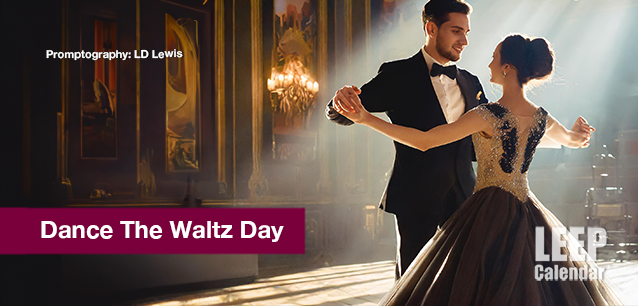 AD
AD
Today is: November 08
Scroll to explore events active on this date.
Additional Events on LEEP
LEEP INK FEATURES

August is Appropos
A toddler playing in the fountain at a park in Santa Fe, New Mexico—Photo LD Lewis. In August, we live through the Dog Days of Summer. It's hot and often humid, and those ...

September is Sassy
Can you hear that sigh of relief from parents worldwide? Yes! September marks the return of students to school, a global phenomenon. Preparations for the ACT and SATs begin earnestly for ...

OOH LA LA, October
October is the busiest month for events, with 5% more happening than in May, the second most eventful month. Sailing enthusiasts will be glued to the finals of this year's Am...
About Dance The Waltz Day
Sports & Fitness
Ends: Mar 04, 2025
DESCRIPTION:
DANCE THE WALTZ DAY
Dance the Waltz Day is a play on the numerical representation of March 4 (3/4), which is a waltz's beat and timing.
The waltz, a dance that epitomizes elegance and grace, has a storied history that spans centuries and continents, evolving from folk origins to becoming a staple of ballrooms worldwide. This captivating dance, characterized by its flowing movements and time signature of 3/4, has reflected and influenced social norms and cultural trends throughout its development.
Originating in the rural regions of Germany and Austria in the late 17th and early 18th centuries, the waltz first emerged from various folk dances, including the Ländler and the Dreher. Early forms featured close holds between partners. This novelty sparked controversy among the upper classes and moralists of the time, who found the physical proximity of the dancers scandalous.
Despite initial resistance, the waltz's popularity surged in the late 18th century, thanks partly to the music of composers like Johann Strauss I and his son, Johann Strauss II, who were dubbed the "Waltz Kings." Their compositions, including timeless pieces such as "The Blue Danube," played a pivotal role in the waltz's evolution into a more refined and sophisticated form. The dance's popularity quickly spread across Europe, making its way into the ballrooms of Vienna, where it became a symbol of Austrian culture and social life.
By the 19th century, the waltz had crossed the English Channel, captivating the British aristocracy and middle classes. Its introduction to England blended fascination and moral apprehension, similar to its reception in German-speaking countries. However, as the century progressed, the waltz became a staple of the English ballroom, aided by the endorsement of figures like Queen Victoria, an avid dancer.
The dance underwent further refinement and standardization during this period, with the development of specific steps and the establishment of dance etiquette that dictated proper conduct on the dance floor. The waltz's tempo also slowed, allowing for greater emphasis on the elegance and fluidity of the movements.
As it continued to spread globally, the waltz adapted to various cultural contexts, giving rise to distinct styles and variations. The Boston Waltz became popular in the late 19th century in the United States, known for its slower tempo and more relaxed movements.
Throughout its history, the waltz has been more than just a dance; it reflects social change, a subject of artistic inspiration, and a medium for personal expression. From its humble origins to its status as a beloved dance genre, the waltz has endured as a symbol of romance, sophistication, and the enduring human desire for connection and rhythm.
Today, the waltz remains a favorite in competitive dance and social gatherings, a testament to its enduring appeal and ability to adapt to changing times.
VIDEOS
SUPPORTING DOCUMENTS
Currently, this event does not have supporting documents.
ADDITIONAL IMAGES
Currently, this event does not have supporting images.
Where would you like to go now?
 AD
AD


/footer-logo.svg)
